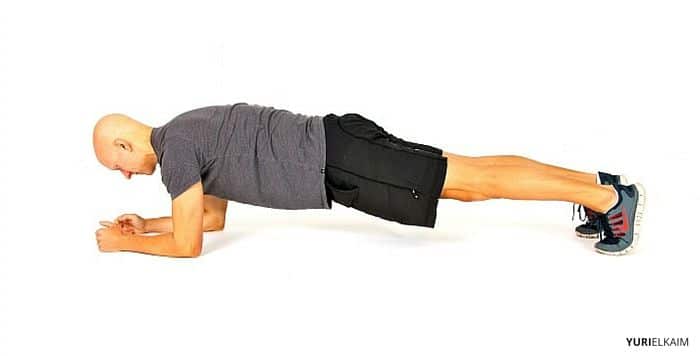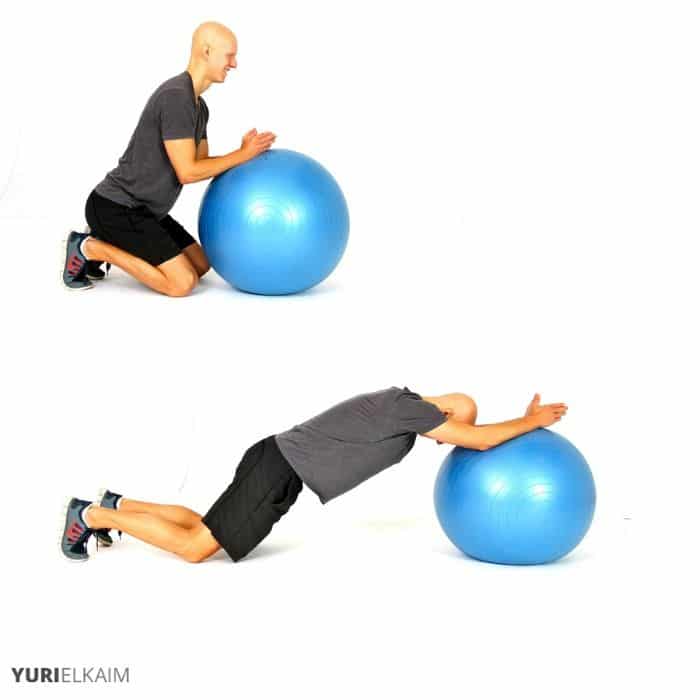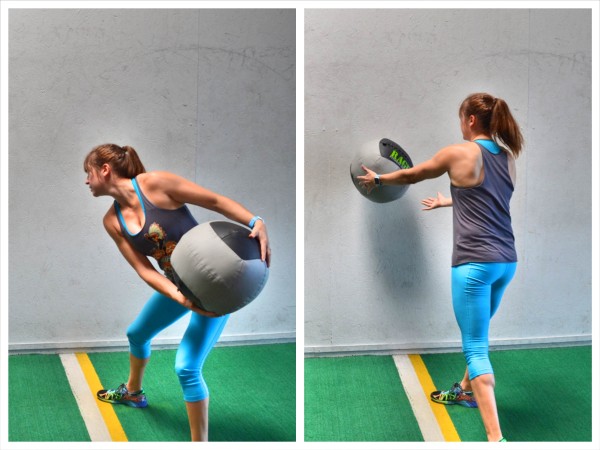In this article
You want flatter abs? (Just like every other person on the planet Earth?)
Well, here’s the question:
Do you actually know how to get them? (Hint: Doing the proper exercises for abdominals vs doing the wrong ones.)
You see, abs don’t care how much you desire them. They don’t care how long you’ve waited.
Flat abs only come to those who truly commit to understanding how to get them and then, applying what they’ve learned.
Sound like hard work?
Sure it does. Because it is hard work.
But it’s not nearly as hard as you might think — if you read on and apply what you learn here.
When it comes to working your abs, it’s really important to focus on the muscles you’re targeting, without putting other muscles – like those in your back – at risk.
Strong Abs, Strong Back
We’re going to focus on building a solid core by learning abdominal exercises that won’t get you in a back injury predicament.
Many of us go to the gym without a road map – when we work out we do a little of this and a little of that, and hope that they’re the right things to make the change we want in our bodies.
But the world of body transformation doesn’t work this way.
[Related: 6 Workout Mistakes to Avoid if You Really Want to Burn Fat]
When you are working out (as is the opposite in life) it’s not who you know that gets you results, it’s what you know. Strange but true.
Read on as we share the eye-opening process of working out your abs into a simple-to-follow strategy even the most newbie fitness person can follow.
So. First things first. What exactly is your core?
A core exercise program should emphasize all of the major muscles that girdle the spine, including but not concentrating on the abs.
While the “core” remains a somewhat vague concept, most researchers consider it the corset of muscles and connective tissue that encircle and hold the spine in place. If your core is stable, your spine remains upright while your body swivels around it.
The muscles forming the core must be balanced to allow the spine to bear large loads. Another way to think of it is that the core is where the body’s center of gravity is located and where all movement originates.
To understand this further, there are three systems that make of your core muscle group:
- Local Stabilization (attach directly to vertebrae) – These muscles include the transversus abdominus, internal oblique, lumbar multifidus, pelvic floor muscles and diaphragm
- Global Stabilization (attach from the pelvis to the spine) – These muscles including the rectus abdominis, external oblique, and portions of the internal oblique
- Movement system (includes muscles that attach the spine and/or pelvis to the extremities) – These muscles include the latissimus dorsi, hip flexors, hamstring complex, and quadriceps
Think of your body as a kinetic chain (because it is), and in order for this chain to work properly, it helps to view this system from the inside out.
In other words, to build a strong core from the inside out, you will want to make sure you are working the muscles that are attached directly to your vertebrae first.
Ideally then, we want to work this way:
Local stabilization to global stabilization to movement system.
Focusing on the outer muscles is like building a house without a solid foundation. It might look great for a little while, but without that stable base, you could find yourself in trouble later.
Work Your Core From Every Direction
A little bit of science and anatomy here: a core training program should regularly manipulate plane of motions, range of motion, modalities (tubing, stability ball, medicine ball, BOSU ball, AIrex pad etc.), body position, amount of control, speed of execution, amount of feedback, and specific acute training variables (sets, reps, intensity, tempo, frequency).
Here’s another fact: A strong core does not equate to simply showing off washboard abs.
Your core is your foundation of strength. Each time you carry the groceries, lift the laundry basket, or throw your kids over your shoulder you are relying on your core. In other words, it is super important!
Strong core = Strong back
The following exercises will help you work from the inside out. But first, a quick physiology lesson.
Core Benefits 101
Core training has been a popular fitness trend in recent years.
The benefits of working out your core are many: A solid core will increase your stability, improve your balance and prevent back injuries. More advanced moves will happen with confidence. Besides looking “ripped”, a solid core can help you achieve total fitness from the inside out.
In a country where it’s estimated that 80 percent of adults have back problems, it makes sense that we learn some proper abdominal exercises.
Let’s get to it.
Best Exercises for Abdominals
If you have struggled on a gym floor, hands clasped behind your head, straining to touch your elbows to your knees, there’s good news: The sit-up and crunch are now no-nos.
So forget about them. Forget about hanging leg raises. That machine in the corner of the gym weight room that twists your spine? Forget that too.
They don’t target the muscles that you want, or they do so in a way that can cause injury or isn’t efficient.
Remember this when engaging in any physical activity/fitness program:
Quality should always be stressed over quantity!
Let’s hit it!
Abdominal Exercises for Stability
First, let’s go with some great beginner moves that ironically require little in the way of movement, but loads in the way of work.
1.“Bracing” and “drawing-in” are two terms that require limited effort but reap big rewards.
Bracing occurs when you have contracted the abs, the lower back and butt muscles at the same time. Drawing in is simply drawing your naval in toward the spine.
A super amazing exercise that you can practice all day, every day to get strengthened and toned abs is this:
Walk around and brace your abs. It’s easy and it works, with one caveat. You have to remember to lightly contract your abs while you’re drawing your belly button in.
This is a super easy and a great isometric way of training your abs for tone, endurance, strength. It will require you to be mindful at first, but over time, your subconscious will take over and it will become second nature.
The best part of this super simple move? It provides flat abs AND spinal stability.
Do this on a daily basis and you will see a flatter stomach in a few weeks, with no back pain.
Here are a few moves that require little movement of your core.
2. Pelvic Tilts
How to do it:
- Lie on your back with knees bent, feet flat on floor.
- Tighten your stomach by contracting it as though you were preparing for a punch. You’ll feel your back pressing into the floor, and your hips and pelvis rocking back.
- Hold for 10 seconds while breathing in and out smoothly. Repeat 8 to 12 times.
3. Dead Bug
How to do it:
- Lie on your back, knees bent at a 90-degree angle.
- Next, lift your legs so that your knees are directly over your hips, your shins parallel to the floor.
- Press your hands into your thighs, with your thighs pushing back into the hands, holding an isometric contraction.
- Draw your belly button down to activate your core muscles.
- Hold that for about ten seconds and relax. You can do that a couple reps, ten seconds on, a couple seconds off, and repeat for a couple rounds.
Yuri Tip: Make sure to keep the abs drawn in throughout the entire movement and that your hips stay glued to the floor so your butt doesn’t “roll” up.
4. Two-Leg Floor Bridge
How to do it:
- Lie supine on the floor with knees bent, feet flat on floor and toes shoulders width apart and pointing straight ahead.
- Lift your pelvis off the floor until the knees, hips and shoulders are in line.
- Slowly lower to floor.
- Repeat.
Yuri Tip: When doing a bridge do not raise the hips too far off the floor as you will hyperextend the lower back which places excess stress on your low back. Contract glutes the entire time.
5. Back Extensions
How to do it:
- Lie face down on the floor.
- Squeezing your glutes, inhale and pull your elbows back toward your knees as you raise your rib cage up from the floor, keeping your neck long and chin tucked.
- Be careful not to come up to high, as you can hyperextend your back.
- Hold for 3-5 seconds, then release.
- Repeat 10-12 times.
Yuri Tip: Do not come too high off the floor as you will hyperextend your back.
6. Plank
How to do it:
- Lie prone on the floor with feet together and forearms on the ground.
- Lift entire body of the ground until it forms a straight line from head to toes, resting on forearms and toes.
- Press your weight into your heels to keep your butt from sagging
- Hold for desired length of time, beginners 30 seconds working up to 2+ minutes.
Yuri Progression Tip: Raise one leg off the floor and hold for 30 seconds. Switch legs and hold.
Abdominal Exercises for Strength
7. Ball Crunch
How to do it:
- Line supine on a stability ball (ball under lower back), with knees bent at a 90-degree angle.
- Place feet flat on floor with toes shoulders width apart and pointed straight ahead.
- Allow back to extend over curve of ball. Cross arms across chest or place hands behind ears of head.
- Slowly crunch upper body forward, raising shoulder blades off the ball.
- Slowly lower upper body over the ball, returning to the start position.
- Repeat.
Yuri Tip: To make the exercise more challenging, perform with arms raised over head.
8. Stability Ball Cobra
Image courtesy LauraLovesFitness.com
How to do it:
- Lie on your belly on an exercise ball (ball under mid-lower abdomen), legs straight out behind you, head relaxed position.
- Gently lift upper body with arms out the side toward your hips. Do not hyperextend back.
9. Side Plank
How to do it:
- Lie on your right side on the floor.
- Lift your body up on your right elbow, which should be directly under your right shoulder.
- Your body should been a straight line from head to feet with your elbow directly beneath your shoulders.
- Keep your neck and ribcage long and strong.
- If this is too challenging, bend your bottom knee and hold the position from there.
- Hold the position for as long as you can without letting your hips drop, then repeat on the other side.
Yuri Progression Tip: Raise one hand to the sky when performing this.
10. Ab Roll Out
How to do it:
- If you have ab wheel that would be ideal, although you can use a stability ball.
- Start on knees and outstretch your arms and place your wrists on ball. Tuck your abs in and brace them.
- Roll ball out and, controlling your body, allow it to follow.
- Pull back up using abs without rounding your spine.
Yuri tip: This is a challenging move. Make sure your lower back is not arched. Visualize your abs contracting to pull yourself back and keep your spine in neutral position at all times.
11. Knee-Drive Plank
How to do it:
- Start with your elbows on the ground directly underneath your shoulders, legs extended behind you with your toes on the ground, so your body is in a straight line.
- Lift your right leg and bring your knee towards the outside of your right elbow.
- Return to plank position.
- Repeat the movement with the other leg.
Yuri Tip: If this is too challenging, simply hold a plank on your elbows or hands for 30 seconds at a time, for three rounds.
12. Bird-Dog Crunch
Note: This is an image of the Bird Dog exercise. It does not include the “Crunch”.
How to do it:
- Start on the floor on all fours, hands placed directly underneath your shoulders, hips in line with your knees.
- Lift your right hand and extend your arm straight out in on you, keeping it shoulder height, while simultaneously lifting your left leg and extending it straight back.
- Your whole body should be in a straight line from right fingertips to left toes.
- Bring your left leg to touch your right elbow under your stomach.
- Extend your leg and arm out again.
- Return to starting position.
- Repeat on the other side
Yuri Tip: If you’re unable to maintain form, simplify this movement by forgoing the crunch. Instead, extend your arm and opposite leg out and hold for three seconds, then switch sides..
13. Pallof Press
How to do it:
- Using a cable tower, connect a standard handle and position the cable to shoulder height. Or, use a resistance tube placed at the same height around a sturdy pole.
- Standing sidelong to the cable or tubing, grab the handle with both hands and step away from the tower, about an arm’s length away.
- With your feet positioned hip-width apart, glutes squeezed, and knees soft, hold the cable to the middle of your chest. This will be your starting position.
- Press the cable away from your chest, fully extending both arms. You core should be tight and engaged.
- Hold this position for 2 seconds before returning to the starting position.
- Do 6 reps, then repeat on the other side.
Yuri Tip: Keep your knees soft and abs and glutes engaged during this exercise, and make sure to breathe.
Abdominal Exercises for Power
Still have fuel in your tank? These exercises will challenge your abdominal muscles in a different way.
14. Rotation Chest Pass
Image courtesy RedefiningStrength.com
How to do it:
- Stand upright with feet shoulder-width apart and toes pointing straight ahead.
- Hold a medicine ball (weighing between 5 and 10 percent of body weight)
- Use your ab muscles and hips to rotate body quickly and explosively 90 degrees.
- As body turns, pivot back leg. Throw medicine with the rear arm extending and applying force.
15. Soccer Throw
Image courtesy RedefiningStrength.com
How to do it:
- Stand holding a medicine ball (weighing 5 to 10 percent of body weight) overhead.
- Quickly throw the medicine ball toward the floor or wall, allowing the arms to follow through.
- Catch and repeat.
Work Your Abs, Save Your Back
So there it is. An entire education in abs with back safety in just one simple post.
Incorporate some or all of these exercises for abdominals into your routine and you’ll soon have six-pack abs (if you are following the right eating plan for you) and a healthy back.
Flat Abs Now!
We’ve learned some of the secrets to building a strong core. Want to know even more?
Discover 7 unknown ways to lose stomach fat and get flat, toned abs – for FREE! Click the banner below to download theseAb Secrets.

















